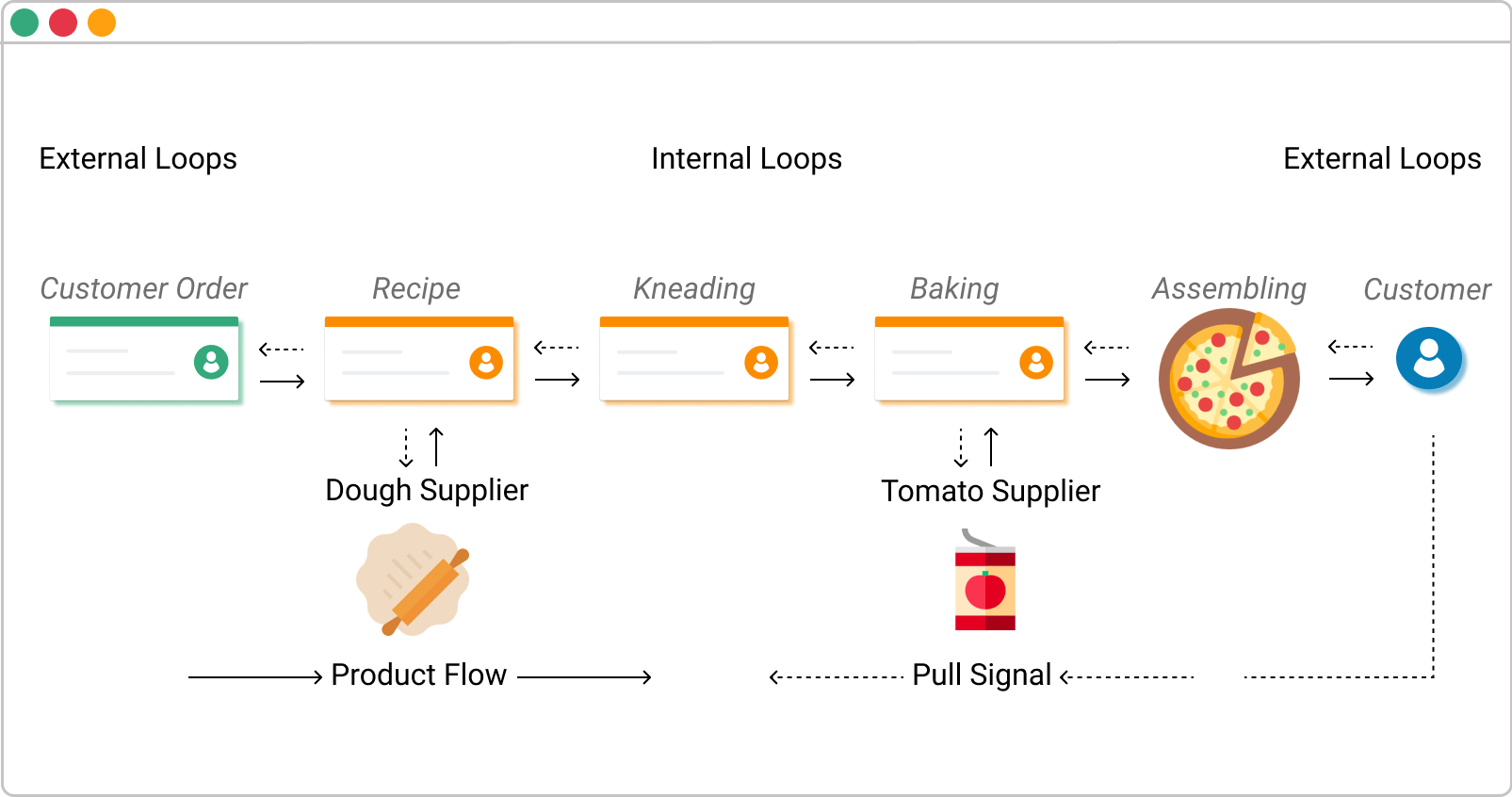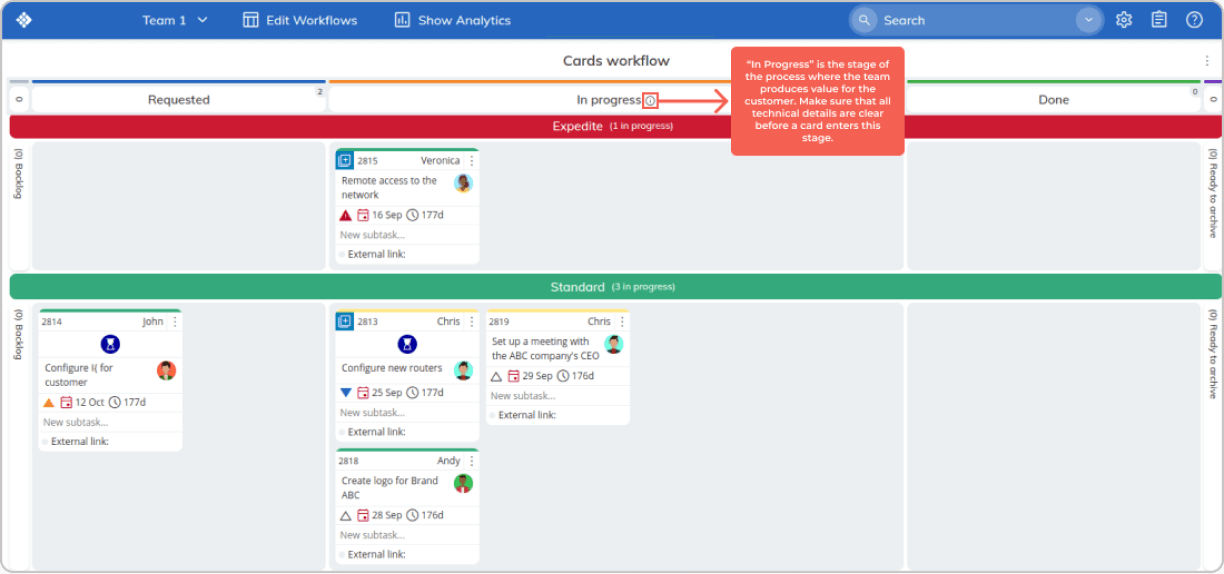Imagine, you are on the way to a subway station and trying to pass the turnstile, you notice your travel card is empty. What are you going to do?
Sure, you will go to the ticket machine and refill the card. In doing so, you are already a part of a pull system based on a certain signal.
In other words, a pull system lets you consume only when you have a demand at the right time.
Aside from your trip to the subway, let’s explore more about pull systems and their application.
What Is a Pull System?
A pull system is a Lean technique for reducing waste in production processes. Applying a pull system allows you to start new work only when there is a demand for it. This allows you to minimize overhead and optimize storage costs.
 Example of how a pull system works
Example of how a pull system works
Why Is Pull Better than Push?
Pull systems are part of the Lean manufacturing principles, born in the late 1940s. A lean pull system aims to create a workflow where work is pulled only if there is a demand for it.
The purpose of implementing a pull system is to build products based on actual demand and not on forecasts. By doing so, your company can focus on eliminating waste activities in the production process. As a result, you’ll be able to optimize your resources and reduce the possibility of overstocking.
Furthermore, applying a pull system will allow you to deliver work "just-in-time".
Just-in-time is a production model where deliverables are produced to meet actual demands and avoid overstocking and push strategies.
When applying a push strategy, a company’s production is based on anticipated demand, which can fail to correspond with the actual demand. Such an imbalance can create unexpected financial gaps.
In knowledge work, the “just-in-time” concept can be applied in the same way as in manufacturing – a work item has to be in progress only if there is a demand for it.
This is the opposite of “Just-in-Case”, where companies tend to overproduce in case of higher demands sometime in the future.
Apple is one of the brightest examples of how a pull system can be successful. Have you ever seen these long waiting queues in front of Apple stores during the iPhone's latest release?
Apple always creates a buzz around their new products, and consumers are always ready to buy. They want to pull the product from the stores.
Apple doesn’t overstock their shops or retail partners. They wait to see if there is a demand for more, and if it increases, they produce more. This way, the company optimizes its resources and achieves high-cost efficiency.
 Pull system production vs. Push production
Pull system production vs. Push production
How To Manage a Pull System in 4 Steps?
Nowadays, the pull system concept is widely spread across various industries. Professionals use it not only in manufacturing but also in software development, customer support, and more.
In the context of workflow management, a pull system allows workers to pull their next task if they have the capacity to start working on it. This may help you prioritize tasks better and prevent teams from overloading. By doing so, your team can stay focused on executing the most important work just-in-time.
To achieve higher levels of productivity and workflow efficiency by using a pull system, you need to consider these four main steps. Let’s explore them further.
1. Establish a Pull System by Visualizing Your Workflow
You can only establish a working pull system and improve the production rate when you can see all moving work items through the flow, spot bottlenecks, and remove any wasteful activities. This is best achieved by mapping your workflow on a visual board like a Kanban board.
Knowing your process is essential for building a visual workflow. Once you have it on a Kanban board, you will have all valuable information recorded and tracked. This first step will help you acquire a full overview and control of your work process.
By applying the concept of the pull system, teams pull new work items when there is available capacity and customer demand for them. In turn, this practice does not create conditions for working on many tasks at a time and only focuses on the requested ones.
2. Apply Pull Signals for Better Flow Management
Pull signals indicate when a work item is ready to move to the next process step. They can prevent team members from pushing more work into the process before finishing the ongoing tasks.
For example, in customer-faced scenarios, teams usually have a column where all incoming customer tickets are stored. When a work item enters this column, team members know the request is now ready to be handled.
3. Control the System with WIP Limits
After building a visual pull system, you need to know how to control it. One of the most common ways to manage your pull system effectively is by limiting work in progress (WIP). This is one of the core Kanban practices, which is a widespread pull system.
 Visualizing a pull system with WIP limits on a Kanban board
Visualizing a pull system with WIP limits on a Kanban board
For example, on a Kanban board, your workflow is divided into different stages such as Ready to start, In progress, Waiting for review, Ready for delivery, etc. By limiting the work that can be in progress at each stage, you will create a smooth workflow and identify problematic parts in it.
This may misguide you to the illusion that your team will not use its full capacity by creating a single-tasking model.
Contrary to the common belief that we should multitask to finish more work, limiting your WIP will actually let your team members focus on single tasks until their completion.
While being focused, your team will be able to achieve excellence through flow efficiency and deliver work much faster.
However, limiting work in progress will not be enough to build a sustainable pull system. You will also need to limit the time a single item can spend in your system.
This limit may vary depending on the size of a task, and it will serve as a requirement. If you forget to do so, some tasks may take a great amount of time in progress and reduce flow efficiency.
4. Make Process Policies Explicit
To ensure consistency in their work, teams can implement process policies and make them explicit on their Kanban board. This Kanban practice aims to establish a shared understanding of the process among team members. In short, Kanban policies are internal agreements that define a set of guidelines that should be followed in the course of work.

Visualizing a process policy for the “In Progress” area on a Kanban board
What Are the Advantages of Using a Pull System?
Unlike push systems, which force team members to work on multiple tasks, a pull system lets team members focus on a single work item at a time. This approach allows a work unit to:
- Quickly adapt to changes that may occur in the work process
- Scale the optimal capacity of your team
- Deliver work items much faster
- Reduce waste of resources
- Increase productivity
- Improve flow efficiency
By using Lean pull principles, you can be much more predictable when planning your future work. How is this possible?
Pull systems allow you to collect historical data about your workflow and the average cycle time of tasks.
Using this data combined with different forecasting techniques, such as the Monte Carlo simulation will give you a probable forecast about how much work can be processed in a predefined period of time.
Pull System Frequently Asked Questions (FAQ)
What Is the Basic Principle of a Pull System?
The basic principle of the pull system is to start work only when needed or requested. The production is based on customer demand and workforce capacity.
What Is the Difference between a Pull and a Push System?
A push system, also called “make to stock”, illustrates a traditional management approach of production where new goods are produced “just-in-case". This means that teams start working on a new item based on anticipated future demand.
A pull system, also called “make to demand”, suggests producing new goods based on a present customer request. The idea here is that teams start working on a new item when there is a demand and available capacity.
We offer the most flexible software platform
for outcome-driven enterprise agility.
In Summary
The implementation of a pull system is an effective way for optimizing resources in a production process. By applying such a system you will be able to:
- Eliminate waste activities
- Optimize cost-efficiency
- Meet actual demand
- Increase productivity and flow efficiency





 Example of how a pull system works
Example of how a pull system works Pull system production vs. Push production
Pull system production vs. Push production  Visualizing a pull system with WIP limits on a Kanban board
Visualizing a pull system with WIP limits on a Kanban board 



